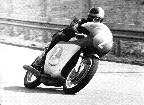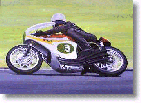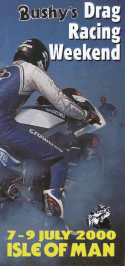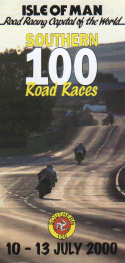| Brought to you in collaboration with The Department
of Tourism and Leisure
|
Reproduced from August 1965 CycleWorld Magazine.
Where to spectate ?
Well they say there are over two
hundred bends so it becomes very much a matter of personal choice and must be
governed by transport or the lack of it. But remember that just as interesting
as the races themselves are the weigh-in procedures that take place the day
before each race in the grandstand area on the Glencrutchery Road. The term
weigh-in , by the way, is a throwback from the early days of racing when the
machines actually were weighed. There you can see your favorite rider fairly
closely and maybe get and autograph or two. A very different proposition from
race day when, within a mile of the start, he will be hurtling down Bray Hill
at over one hundred miles an hour. So if you like sheer speed then go to the
bottom of Bray Hill where the bikes are doing about a hundred and thirty as
they aim between the curb and drain cover if on the proper racing line.
Then comes the slow right-hander at
the Quarter Bridge, always crowded and very popular, which in turn is followed
after a short straight by Braddan Bridge where the left and right sweeps over
the bridge give one of the best opportunities to study riding styles.
Then on and out through Union Mills
and Crosby until just after five miles the Highlander is reached, a flat-out
section now very smooth where a 250 Yamaha has been timed at over 140 mph. At
Ballacraine the course turns right and enters the difficult Laurel Bank and
Glen Helen sections, also difficult from the spectating point of view, then
climbs up Creg Willey's hill onto the Cronk y Voddee straight, on past the
eleventh milestone, Handley's Cottage, and then to one of the most exciting
points the circuit has to offer-Baaregarroo. At the bottom of the hill is a
flat-out left-hander and from here, if you have your own transport, it is
possible to drive to the 32nd milestone up on the mountain while the race is
on.
From Baaregarroo the course goes on
to Kirkmichael until at the seventeenth mile point Ballaugh Bridge is reached.
An excellent point to watch and 1965 may be the last time that the riders leave
the ground as they take the humped-back bridge, for the Highway authority wants
to flatten the bridge. Three miles later comes two of the best spectating
points less than half a mile apart, Sulby Bridge and Ginger Hall, the later
offering particularly good opportunity to the budding photographer.
So
to Ramsey with its crowded square and famous hairpin leading up to Waterworks
corner. Then the long climb up the mountains with the Gooseneck offering a
fabulous view back over Ramsey Bay and a nasty, slow right-hander that finished
Phil Read's senior ride in 1961 when he dropped it there when lying fourth,
having won the junior race earlier in the week.
The mountain section is over nine
miles long and ends in spectacular fashion with the plunge down from Kates
Cottage to Creg ny Baa. A good spot this, for plenty of coaches go there from
Douglas and it is possible to walk up to the Keppel Gate and see a bit of the
mountain section. The one mile stretch from the Creg to Brandish is possibly
the fastest section of the course and leads to Hillberry, a fast right-hander
that can be a heart stopper for rider and spectator alike.
Now it is
less than two miles to the finish past Signpost corner and Bedstead to the ever
popular Governor's Bridge where riders are slipping the clutch in bottom gear
around the hairpin and through the dip before the short stretch along the
Glencrutchery Road to the finish.
If you stay at the grandstand
throughout the race then you see the pit stop dramas and have the leader board
in front of you to tell the race story as it proceeds.
By Friday you
will have made up your own mind just where you want to see the 500's. For by
then the atmosphere will have grown on you and you will have realized that the
Isle of Man is a tradition. Whether you arrive by boat and see the two mile
sweep of Douglas Bay with Snaefell dominating the mountains in the background,
or by plane and run into Douglas on the airport bus and hear the conductor
mutter a greeting in Manx tongue to the little folk as he raises his cap at the
Fairy Bridge, you will sense here is somewhere refreshingly different.
Tail-less cats, horse-drawn toast rack trams and an "olde worlde" narrow gauge
railway are all part of an Island steeped in history. The races are adding to
that history with the names they have given to parts of that thirty-seven
miles: Doran's Bend, Handley's Cottage, Birkin's Bend, the Thirty-third and
Brandish are now almost as much a part of Manxland as names like Ballagarey,
Cronk y Voddee, Snaefell and Druidale. This is just as it should be, for
nowhere else in the world is there a course which offers such a challenge to
man and machine.
|
| Back
|
|
|
|
Mann Fact
The first TT
of the new millennia will start earlier than ever with practising set to
commence on the Saturday evening of May 27. Subject to confirmation by the
Department of Transport, practising will get underway 36 hours earlier than
normal with an evening session similar to that introduced to the Manx Grand
Prix some Years ago.
Southern 100
Peveril Motorcycle
Club
503 F2 Racing Team
Classic Racing Motorcycle Club
Cafe Racer



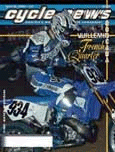


Greeves Motorcycles
Aermacchi
History
The Motorcycle Museum
|
